#Best Hospitals for Children India
Text
Contact us for the best Psychiatric Treatments in Bangalore

Contact Maarga Mindcare for Severe Depression and other mental illnesses. We offer mental health treatments for psychological disorders. Book counselling now Best Psychiatrists in Bangalore
#Best Psychiatrists in Bangalore#Best Counselling Psychologists in Bangalore#Best Psychologist Doctors in Bangalore#Psychiatric Treatments in Bangalore#Best Mental Hospitals in Bangalore#Children Mental Illness Hospital in Bangalore#Best Depression Treatment Centers in Yelahanka Bangalore#Anxiety and Depression Treatment Centers in Bangalore#Best Doctors for Anxiety Treatment in Bangalore India#Doctors for Anxiety Treatment in Yelankha Bangalore#Best Anxiety Disorder Counselling Doctors in Bangalore#Doctors for Social Anxiety Disorder in Bangalore#Best Doctors for Panic Treatment in Bangalore#Rehabilitation Centre for Depression in Bangalore
2 notes
·
View notes
Text
The conventional or allopathic treatment for pediatric epilepsy usually involves anti-epileptic drugs (AEDs), which aim to control seizures by stabilizing the electrical activity in the brain. These medications can be highly effective, but they also come with potential side effects, including drowsiness, fatigue, mood changes, and, in some cases, cognitive impairment. Despite their efficacy, many parents are concerned about the long-term use of AEDs and seek complementary treatments to enhance their child's well-being.
#epilepsy#neeraj epilepsy clinic#best epilepsy treatment in india#best hospital for epilepsy treatment in india#ayurvedic epilepsy treatment#epilepsy treatment#best epilepsy treatment#pediatric epilepsy#best epilepsy treatment for children
0 notes
Text

Best kangaroo care hospital in KR Puram: slmckangarocare
Hospitals play a crucial role in providing healthcare services, especially specialized care like kangaroo care. In KR Puram, slmckangarocare Hospital stands out for its exceptional kangaroo care services. With a team of skilled medical professionals, the hospital offers personalized and compassionate care to premature infants and their families. Its modern facilities and advanced technology ensure a warm and nurturing environment for both infants and their parents. The hospital's commitment to kangaroo care promotes bonding and development.
#Best kangaroo care hospital in KR Puram#Best Mother and children hospital in KR Puram Bangalore#Location: India
0 notes
Text
#Best Psychiatric Hospitals in Bangalore#Best Psychiatrists in Bangalore#Best Counselling Psychologists in Bangalore#Best Psychologist Doctors in Bangalore#Best Mental Hospitals in Bangalore#Children Mental Illness Hospital in Bangalore#India#Best Depression Treatment Centers in Yelahanka Bangalore#Anxiety and Depression Treatment Centers in Bangalore#Best Anxiety Doctors in Bangalore India#Best Doctors for Anxiety Treatment in Bangalore India#Best Anxiety Disorder Counselling Doctors in Bangalore#Best Doctors for Panic Treatment in Bangalore
0 notes
Text
Pediatric surgery is a sub-specialty of general surgery that specializes in the surgical care of infants, toddlers, children, and adolescents of all ages, including newborns and children less than one year of age. Pediatric surgeons are the medical specialists responsible for performing these procedures, having developed a pre-operative plan according to the patient's physical and clinical assessment findings. Depending on the person carrying it out, the task might be broken down into various areas of expertise.

Pediatric surgery is a sub-specialty of general surgery that specializes in the surgical care of infants, toddlers, children, and adolescents of all ages, including newborns and children less than one year of age. Pediatric surgeons are the medical specialists responsible for performing these procedures, having developed a pre-operative plan according to the patient's physical and clinical assessment findings. Depending on the person carrying it out, the task might be broken down into various areas of expertise.
Surgery in various specialties, including general, urological, gynecological, and cardiothoracic, is provided. This field of medicine has recently seen the emergence of a new subspecialty enjoying explosive growth: prenatal surgery. Because of the vast differences in the physical and mental maturation of the young and adult populations, pediatric surgery is an important and separate field of study.
Conclusion
If you want your kid to have the best possible surgical treatment, you need access to a skilled pediatric surgeon in Udaipur. Surgeons specializing in pediatrics have mastered the art of assessing and treating kids in a manner that encourages cooperation. Pediatric surgeons also make use of equipment and facilities designed specifically for use on young patients.
The goal of a checkup is to keep you healthy, not to alleviate any symptoms you may be experiencing right now. Wellness visits, preventative visits, health evaluations, and comprehensive medical exams are all names for the same thing.
Best Hospital in Udaipur | Best Cancer Hospital in India
Read full blog here: https://www.geetanjalihospital.co.in/blogs/view/importance-of-pediatric-surgeries-and-routine-checkups
0 notes
Photo

Without children, the world would be devoid of sunshine, laughter, and love. That's why children are the most precious creation, and we should protect, guide and love them with all our might. Happy Children's Day!
#happy children's day#Best Cancer Specialist in Mumbai#best cancer hospitals in India#Best Cancer Hospital#bestcancerhospital#best oncology hospital in Hyderabad#Basavatarakam Cancer Hospital#Basavatarakam Indo American Cancer Hospital#basavatarakam hospital#basavatarakam#basavatarakamcancerhospital balakrishna basavatarakam#indo american cancer hospital#indo american hospital#indo american hospital hyderabad#Indo American Cancer Hospital Hyderabad
0 notes
Text
Best Pediatrician in Bangalore
Child hospitals give comprehensive and nonstop consideration to pediatric asthma cases, among different administrations. The nursing staff, specialists, and specialists have immense information and experience doing combating different children’s lung problems in babies and Children. Through our way to deal with restorative consideration, we urge Children to develop and form into the people they wish to turn out to be, regardless of any disease they might have contracted.
Considering this vast area of expertise, well-child checkups and baby vaccination in Bangalore will provide the same degree of comprehensiveness and completeness for newborns and children under five. We would love to have an opportunity to serve you and help you in your journey of child-care for your precious little ones!
best pediatric doctors in Bangalore have elite professionals in many areas of pediatric care. For example, a team is available for pediatric surgery for complicated procedures in children, and others for Neonatology, Pulmonary Disorders, Allergies, Endocrinology, Dentistry, Orthopaedics, Speech Therapy, Psychiatry, ENT, Neurology, and Dermatology- to name a few.
top pediatricians in Bangalore are unparalleled, and they would love to be a part of this most special journey of your life! We at Shishuka offer an environment where the baby and mother can both grow in the days immediately after childbirth. Our aim of creating a happy atmosphere and the holistic care provided to mothers and babies is what makes the transition easier for both.
#child hospital#child health#children health#best hospital in bangalore#hospital in india#hospital#health & fitness#mother and baby#child care#children
0 notes
Photo

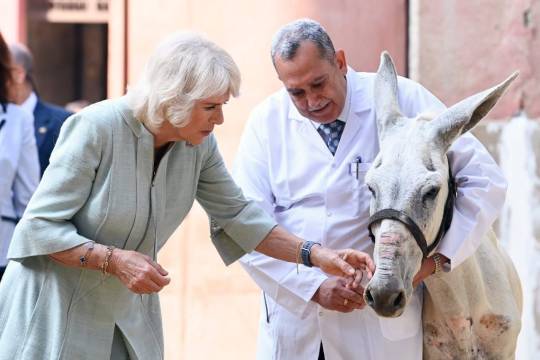
Queen Camilla’s Patronages
The Brooke Hospital for Animals (President from 01.11.2006)
Brooke is an international charity that protects and improves the lives of horses, donkeys and mules which give people in the developing world the opportunity to work their way out of poverty.
We believe that animal suffering is preventable and that good animal welfare protects human livelihoods. For 600 million people in some of the poorest places in the world, 100 million of these animals are the backbone of communities and their best means of making a living. Without healthy working horses, donkeys and mules, they wouldn’t be able to put food on their tables, send their children to school or build better futures for themselves and their families.
We work with owners, communities and policy makers to bring about lasting improvements to the lives of working animals. Brooke works hard to deliver significant and lasting change, even in some of the world’s most challenging areas. We use our expertise to train and support owners of horses, donkeys and mules, local vets, farriers, harness makers and animal traders to improve standards of care.
“As President of this unique charity, I am proud to tell you that the Brooke reaches more working horses, donkeys and mules than any other animal welfare charity. For over 80 years, the Brooke has been sharing its experience and expertise to improve the welfare of working equines around the world. I have witnessed the Brooke’s work for myself in Petra, Jordan and in 2013 I was able to meet and personally thank Brooke staff in India for their role in Uttarakhand, where the Brooke India team provided emergency relief to stranded equines in various pockets of the flooding disaster affected area.”
- Queen Camilla
40 notes
·
View notes
Text
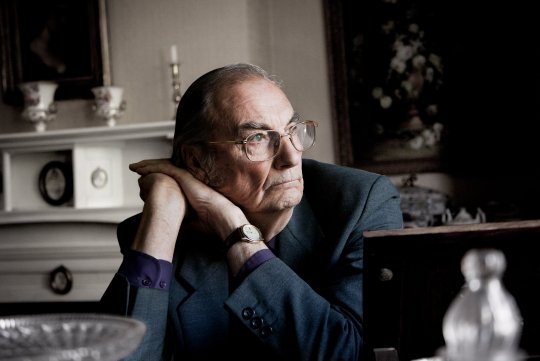
The much-quoted phrase “Grief is the price we pay for love” reached a global audience in 2001 when Queen Elizabeth II used it in her message of condolence to those affected by the 9/11 attacks in the US.
But it was the psychiatrist Colin Murray Parkes, who has died aged 95, who first came up with the words that have given solace to so many. In his 1972 book Bereavement: Studies of Grief in Adult Life, he wrote: “The pain of grief is just as much a part of life as the joy of love; it is, perhaps, the price we pay for love.”
When Parkes first proposed a research project on bereavement while working as a psychiatrist at the Maudsley hospital in south London in the 1960s, a professor responded: “What you have described isn’t a project, it’s a life’s work.” And so it proved.
Having noted that grief rarely featured in the indexes of the best-known psychiatry textbooks, he went on to write and co-author hundreds of research papers, and further books including Facing Death (1981); Death and Bereavement Across Cultures (1997); and Love and Loss: The Roots of Grief and Its Complications (2006). A selection of his works was published in 2015 as The Price of Love.
He was regularly called upon to provide assistance in the aftermath of large-scale disasters and admitted to finding this harrowing. Recalling his visit to Aberfan, the Welsh village near Merthyr Tydfil where a colliery waste tip collapsed on 21 October 1966, killing 116 children and 28 adults, he said: “The first time I drove away from the village I felt utterly helpless. Everyone I talked to had been desperate. I had to stop the car three times because I couldn’t carry on. I just needed to stop and cry.”
In April 1995 he was in Rwanda at the invitation of Unicef, who asked for his help in setting up a recovery programme following the previous year’s genocide there. He attended the reburial of 10,000 bodies that had been dug up from mass graves and felt haunted by his experiences in the country for the rest of his life.
After the terrorist attack on the World Trade Center in September 2001, in which 2,977 people died, Cruse – the bereavement charity of which Parkes was life president – was asked to send a team to New York to support the families of British victims. The biggest problem, he recalled, was making real to those families the unimaginable horror that their loved one was never going to come back. “Bereaved people can make it real, but it does take a long time. They have to go over it again and again, and think their way through it,” he said in an interview in the Independent shortly afterwards.
He also worked with those affected by the 1973 air crash near Basel, Switzerland, in which 108 died, mainly women from Axbridge, Somerset; the Bradford City stadium fire in 1985, in which 56 lost their lives; the Herald of Free Enterprise disaster in which 193 died after the ferry capsized near Zeebrugge, Belgium, in 1987; and the bomb explosion in a flight over Lockerbie, Scotland, in 1988 that killed 243 passengers, 16 crew and 11 residents. Parkes also travelled to India to assess the psychological needs of people bereaved by the 2004 Indian Ocean tsunami.
He said: “One of the most awful things about bereavement is that the world goes on as if nothing had happened. For bereaved people the world is never going to be the same again.”
Born in London, Colin was the son of Gwen (nee Roberts), and Eric Parkes, a solicitor. After attending Epsom college, in Surrey, he went to Westminster hospital medical school (now part of Imperial College London), qualifying as a doctor in 1951.
He worked for two years as a junior house physician at Westminster, then at Kettering general hospital in the Midlands. After two years’ national service with the RAF medical corps, he joined the Institute of Psychiatry, based at the Maudsley.
Following the publication of his research into bereavement in 1962, he joined the Tavistock Institute of Human Relations. There he worked with the psychologist John Bowlby for 13 years, disseminating the model of grief as consisting of four stages: numbness; pining; disorganisation and despair; and recovery.
Parkes was also instrumental in the introduction of bereavement services in hospices from the 1960s. He worked closely with Cicely Saunders – “the single-minded mother of palliative care with whom I shared angst at the scandalous ways our fellow doctors were treating patients faced with death and their families” – on the planning and launch of St Christopher’s hospice, Sydenham, in south London, in 1967.
Both were convinced that good care must involve families as well as patients. Parkes set up a bereavement service of trained volunteers who went into families’ homes and organised support groups, including some for staff, in the hospice. He remained involved with St Christopher’s until 2014, active as a consultant psychiatrist until 2007. He also performed this role at St Joseph’s hospice in Hackney, east London (1993-2007).
“He was a towering intellectual and hugely influential, but never took himself too seriously,” said the former chief executive of St Christopher’s Barbara Monroe. “He always remained a great clinician – very good at talking to patients and staff. And listening.”
In 1975 Parkes left the Tavistock to take up a senior lecturer role in psychiatry at Royal London hospital medical school, retiring from that post in 1993. His association with Cruse began in 1964, as a member of the council. He became chairman in 1972, and was made life president in 1992. Four years later he was appointed OBE.
Parkes edited the journal Bereavement from its launch in 1982 until 2019. Given the Times/Sternberg award – which celebrates the achievements of those over 70 – in 2012, when he was 84, he urged people to spend the last part of their lives in worthwhile work. “I was basically forced to retire at 65 and I got lots of cards with old men fishing on the front. But life is too short for retirement and the time has given me the opportunity to do things I would not otherwise have done,” he said.
In 1957 he married Patricia Ainsworth. She and their daughters, Liz, Jenny and Caz, survive him.
🔔 Colin Murray Parkes, psychiatrist and author, born 28 March 1928; died 13 January 2024
Daily inspiration. Discover more photos at Just for Books…?
8 notes
·
View notes
Text
Read Out What Sets Escon Panache Apart?
Finding the perfect home is a dream for many, and Escon Panache is here to turn that dream into reality. Nestled in the serene and upscale of greater noida, Escon Panache offers 4 BHK Luxury Villas in Greater Noida that redefine modern living. But what truly sets Escon Panache apart? Let's explore the unique features and benefits that make this property a standout choice.

Prime Location
One of the most significant advantages of Escon Panache is its prime location in greater noida. This area is known for its excellent connectivity, with easy access to major highways, metro stations, and the upcoming Jewar Airport. Living in Escon Panache means you are just a short drive away from bustling city life while enjoying the tranquility of a peaceful neighborhood.
Luxurious Villas
Escon Panache offers luxurious villas that are designed to provide the ultimate comfort and elegance. Each villa is a masterpiece of modern architecture, featuring spacious interiors, high-quality finishes, and state-of-the-art amenities. Whether you are looking for a cozy family home or a lavish retreat, Escon Panache has something to suit your needs.
World-Class Amenities
What sets Escon Panache apart is the range of world-class amenities it offers. Residents can enjoy a well-equipped gym, a refreshing swimming pool, beautifully landscaped gardens, and a clubhouse for social gatherings. The community also boasts dedicated play areas for children, jogging tracks, and ample parking space. Every aspect of Escon Panache is designed to enhance your lifestyle and provide a sense of community.
Green and Sustainable Living
At Escon Panache, we believe in sustainable living. The property is designed with eco-friendly practices in mind, featuring rainwater harvesting systems, solar panels, and ample green spaces. Living in Escon Panache means you are contributing to a greener and more sustainable future.
Security and Safety
Your safety is our priority. Escon Panache is equipped with top-notch security systems, including CCTV surveillance, 24/7 security personnel, and controlled access points. You can rest assured that your family is living in a secure environment.
Flexible Services
Living at Escon Panache means having all essential services within reach. The property is close to reputed schools, hospitals, shopping centers, and entertainment hubs. You won’t have to travel far to access the best facilities and services that Greater Noida has to offer.
Best Investment Opportunity
Escon Panache is not just a home; it's an excellent investment opportunity. The property value in greater noida, is consistently on the rise, making it a wise choice for investors. With its luxurious offerings and prime location, Escon Panache promises a high return on investment.
Escon Panache Villas stands out in the real estate market for all the right reasons. Its prime location, luxurious villas, world-class amenities, commitment to sustainability, and top-notch security make it the perfect choice for those seeking a dream home. Whether you are looking for a place to call home or an investment opportunity, Escon Panache offers the best of both worlds.
Discover the luxury of living at Escon Panache. Experience the difference today! Connect with us to know more about us.
Visit us:- www.esconpanache.com
Ref:-https://esconpanachevilla.blogspot.com/2024/07/finding-perfect-home-is-dream-for-many.html
Location: Greater Noida, Uttar Pradesh, India
#4bhkvillaingreaternoida#4bhkluxuryvillas#4bhkvillainnoida#esconpanachevillas#smartluxuryvilla#4bhkluxuryvillasingreaternoida
4 notes
·
View notes
Text
Indigencies
My father grew up dirt-poor in a village in India. My grandmother valued education, and with her prompting, he managed to get an engineering degree and an educated wife, coming to the United States.
Alternatively: my mother’s mother was the most hardworking woman in the world, running multiple businesses, doing the housework, and raising her children. As a high schooler, she held an (unsuccessful) hunger strike to promote her right to an education. She passed on that determination to her daughter. Between my mother’s ludicrous work ethic and terrifying ambition, she found a husband with her goals and gained a medical degree in two countries, settling in the United States.
Either way, my mother and father, through luck and hard work, came here with the skills to better this great country. My mother maintained throughout my childhood that there was nowhere to gain success like the US. She worked at a hospital until the administrators determined that an endocrinologist wasn’t profitable enough to justify on staff, at which point she opened her own practice. My father worked at a bank until one of his college friends suggested an entrepreneurial software-producing business, and as such, Multicoreware was born. Both of them brought new jobs to Sunset Hills and provided a necessary service that wouldn’t have existed if they weren’t there.
The word “indigenous” means “native to the land one is living on,” but the term “indigency” simply means “poor.” My family is, under some definitions, indigenous to India, but according to all definitions, we suffer indigence nowhere. We have, in fact, never suffered indigence in our lifetimes. My dad got his education through scholarships, but he did get his education. My mother was even more privileged. Don’t get me wrong, she didn’t have air conditioning or pasteurized milk. She was still wealthy by most Indian metrics, though, and that wealth allowed her to get a degree, which was fundamentally important in getting her green card.
That’s important. Regardless of how you spin their rags-to-riches story, neither of my parents literally started in rags. My father got closer than my mother, but ultimately, neither of them were starving on the street, and there are a lot of people in India starving on the street. Those people don’t end up in the US.
Did you know that not all Asian Americans are wealthy? I don’t mean that literally, obviously some Indians start gambling recklessly or get trapped by a lack of universal healthcare. I mean that “Asian American” is a demographic so large as to be useless. If you break down the overall group, you’ll find we’re harshly divided between people who immigrated like my parents and refugees, making up the top 10% and bottom 10% of US earners. Isn’t that funny?
My family’s from Missouri, Saint Louis specifically.
In the meantime, my parents bought a suburban house and had two daughters. Becoming a doctor or engineer is well-known in India as a ticket to success, but my parents taught my sister and I to value the opportunities this country had, so we followed our hearts instead. My sister bounced around for a while, studying psychology and sociology, but she settled on educational nonprofit work, helping kids in India succeed. She works in fundraising, convincing potential philanthropists that their cause is a good enough one to sponsor. My sister is, I’ve been told, very good at her job; listening to all the office politics is always amusing. I became an ecologist and conservationist. It’s less of a non-sequitor than you’d think: my family adores national parks and hiking, and there’s something so fundamentally beautiful about this continent. Come to the Midwest: we have the best thunderstorms in the world. My job is something I would never get to do in India, and it’s good chunk of the reason I’m so grateful for this country.
On a related note, I said that indigenous means “native to the land one is living on,” but it is more complicated than that. Indians living in India, for example, are rarely called indigenous. It’s a specific kind of colonization that creates the concept of indigeneity. The settling of other people on your land is a necessary step of the process.
Even if that wasn’t true, I wouldn’t be indigenous anywhere. I was born in Missouri: even if I return to India, I will be an American returning to the place of her forefathers, not an India returning to their home country.
There’s actually a thriving Tamilian community in Saint Louis. That’s the reason my parents chose to move there. Of course, by the time I was old enough to really notice social atmospheres, we’d ended up alienated from said community through common drama, so that didn’t affect me much.
By the time I was born, my family had established a pattern of traveling to visit India every year or every other year. Though it is important to understand your roots, we go there for more practical reasons. My grandparents deserve to know me, and my mother runs a charity organization.
The organization has warped over time. At first, we helped fund a school. Then, my mother began running diabetes clinics for rural Tamilians. Nowadays, my mother has been campaigning for an increase in millet-based diets instead of white rice-based diets.
I don’t think either of my parents want to move back to India. It’s still important to take what we’ve learned in the US and return it to India. We owe the country that much.
The result of all of this is that it’s accurate to say my family is from a colonized culture, not an indigenous one, but I am from neither. Within the US, we are primarily aligned with a colonizer culture, enjoying its luxuries and upholding its narratives. I’ve been saying for years that I am more American—using “American” to mean “from the United States,” which is its own can of worms—than I am Indian. I was born in the US, and I was brought up here. These are the opportunities that I have most enjoyed. This means that, regardless of my genuine love for this country, I am a colonizer that has put down roots.
I wonder, sometimes, if I would have connected more with India if I connected more with the community in Saint Louis. I probably would have, I think. I barely know how to celebrate Diwali, and I don’t know any of our other holidays. I’m Hindu in a lazy, abstract way. I don’t speak Tamil.
On the other hand, I’m Indian enough that I don’t get to be American, not all the way. I’m not a pie chart—70% American, 25% Indian, 5% something else—but I might as well have been, the way people used to talk to me.
I’ve gotten something else from our trips to India, though. I’ve knelt in stone temples and before my great-grandmother. I’ve wandered through drip-irrigated farmland and watched my mother bring reusable bags from India because there was nothing like our woven bags in this country. Frugality, sustainability, humility, and spirituality all mean the same thing to me, nowadays. As we were bringing our Western education to our home country, I brought pieces of my home country back to the West.
As an ecologist, this is tricky. In a lot of ways, my field is simply an attempt to gather the knowledge that indigenous people already knew, and we have a bad habit of writing off their credits or overwriting their narrative. On the other hand, my family is from a colonized culture, and there’s a chance my perspective will be worth something because of that. I cannot turn my back on this field. It’s my duty, as somebody who has a chance of understanding the tangles in the connection between culture and conservation, to remain in this field, attempting to help where I can and uplift marginalized voices.
I went to India in high school then again just after the pandemic, and I think I found something worthwhile there. I mean, at first I had to really search for it; I don’t know how my sister finds it so easy to love that country. I really did try, though, and I did find something. I went to this farm vaguely connected to the school my family used to help fund—I don’t think we’re involved anymore, and my mom’s current charity efforts are leaning more chaotic than anything—and I noticed that they were using drip irrigation. After that, I started looking for that sort of thing, and I found it absurdly common. The average Indian I’ve met has no concept of conservation, but they do understand waste and how to avoid it, and often there’s heavy overlap. There are also cultural values surrounding the concept of duty, mindfulness, and practicality that I think really are valuable: I doubt Rama would have much time for fast fashion, prince or no.
As an adult who knows how to look at the world through a cultural lens, I’ve been trying to learn about other culture’s views on conservation as I do my research. UC Davis is trying to include more information on Native American views on sustainability in its curriculum, and I’ve been reading Braiding Sweetgrass in my free time. It’s important to weave scientific methods with indigenous knowledge when promoting sustainability.
Still, I’m worried that I’ll become as complicit, as academia isn’t always built to further true understanding. We have a way of talking as though we have knowledge and indigenous groups have practices, when in reality it’s much more complicated than that.
After that, I started putting real effort in, and I think I’m doing a good job of it. I read the Gita, which was a very good book, and Sundara Kanda, which really wasn’t. I’ve been wearing churidars the last few years, and I bought a Saraswati statue to put next to my Ganeshas. I started meditating. I learned to make chapathi. How many pieces can you put together before you’ve made one whole Indian?
And I really am trying to take this understanding of why culture is important and use it to reach out to others. Solidarity is really important. Did you know that it’s an Indian who attacked affirmative action most recently, the idiot? How do they not realize that racism chips at us all—
Anyways. I inexplicably started with Judaism—well, not inexplicably, I got guilty when I realized I knew more about Nazis than Jewish people—trying to get a shape of what cultural practices look like in the US. I don’t think I did an amazing job, but there’s only so much you can get from books. After that, I started reading more international authors, which I’m not certain did anything, but I enjoyed The Locked Tomb series immensely, so maybe it’s alright.
Cultural understanding is incredibly important work and, in ecology, time bound time bound. We are embedded in a mass extinction of our own making, and we need to work immediately to prevent everything from getting worse. As such, I’m getting a Masters degree, the a PhD, then I’ll get an entry-level government position and work steadily to—
Of course, leaving academia and moving to direct activism would be the most morally correct thing to do, but I’m not certain I have the personality matrix for it. Perhaps I should invest more of my free time into volunteer work.
Most importantly, I really am trying to understand the Native American perspective on the United States, specifically from within California because understanding one culture well seems better than stereotyping a million, but that’s such a massive undertaking, and I really don’t want to come off too white savoir-like as I do it, and if understanding Judaism from a book is impossible I don’t know why I’m trying with Potawatomi culture, Jesus Christ at least I’ve met a Jewish person before—
It’s not about understanding every culture on earth; I understand that. My curiosity drives me to understand everything, but from most people, all that I have are whispers. An rudimentary understanding of Chi from Iron Widow overlaid with giant mechs and messy polyamory. The Peruvian Sacsayhuaman, meaning vulture feast, after the mass of bodies that lay there after the conquistadors had finished their work. The layer of powder on temples in India, leftovers from the stuff that’s supposed to go on your forehead.
It just feels wrong to know so little about the land I’m walking on. A’nowara’kó:wa means Turtle Island, and according to Braiding Sweetgrass, that’s the actual name for North America. I learned that a month ago.
I kind of hate India, but I know it’s mine. It’s not like the US which I’ve had to claim over and over again. The US had to be imprinted on to me through birth certificates and accents and yelling “I am a patriot!” at disruptive times. I was Indian the moment I was born; the land itself is pressed into my skin.
The land I was born on belongs to someone else. It’ll always belong to someone else. That’s not okay, but it has to be.
The work we’re doing is difficult, but it’s the only practical way to make a difference.
We need a revolutionary change, and soon. Continually spinning my wheels like this is useless.
You know how the word “Indian” doesn’t mean actual Indians in the US? I mean, it might be different nowadays, but when I was a kid, “Indian” meant Native American first. I have, in the 20 years of my life, refused to refer to Native Americans as Indians, even when that was their preference. I don’t care that it wasn’t their fault, that “Indian” was as imposed on them as it was stolen from us. It’s our word.
Well, recently I learned that “Indian” wasn’t created by Indians either. The Greeks saw people living around the Indus River and started calling them Indians, but even “The Indus River” was a Greek term: the original word for it was Sindhu.
That’s not why my parents named me Sindhu. They wanted a Tamil name, and for us, Sindhu means “music,” and music is something transcendentally meaningful. It’s funny: that’s not an Indian thing, I don’t think, but it still feels Indian. All of this feels Indian. When I think of India, I think of grime and exhaustion, but when I think of Indians, I think of bright colors and music and how God connects us to the natural cycle. No wonder their country was named after a river, after music. No wonder I am named after my country.
One of the frustrating things about engaging with culture is that it’s the kind of work that’s never finished. It feels like mental health upkeep: it’s vitally important, and if you ignore it long enough you collapse, but lord is it exhausting. We need to put the work in to understanding each other, and colonialism is so baked into the fabric of the US that I don’t think we can progress without addressing it. That doesn’t make it easier to lose and gain appreciation for your country on loop. When an immigrant assimilates, how do they differ from the colonizers that surround them?
I don’t think I’ll ever be happy with my relationship to India. There’s always something more I could be doing, another revelation on the horizon. I don’t think I’ll ever be happy with my relationship to A’nowara’kó:wa either. I just live on it.
#Indigence means poverty.#This is the best thing I've written for library of babel hands down#i'll almost certainly edit it to make a real piece#fun fact: the color scheme was originally black-red-green but I switched it for the sake of color blind people#this started from a scholarship essay#the gist of which is written in the black text#I do agree with what I said in that essay but I also agree with the other two narratives I put down#Or not agree with precisely#things can be emotionally true without being literally true#colonialism#us imperialism#immigrant daughter#immigration#indian american#tamilian#the american dream is killing me#creative writing#my writing#library of babel#unedited#original works#new writers on tumblr#ecology#i don't want to put anything in the indigenous tag considering im not indigenous#so i guess we'll end it there
6 notes
·
View notes
Text
Salma Shaikh, 34 (India 2016)
3 years after his wife and child were killed, Shabir Shaikh was still fighting for justice. Although police had identified the killer and issued a notice for Salma’s death, no action had been taken against the man who killed her. Salma was killed by a legal abortion.
Shabir’s wife Salma underwent a legal abortion in 2016. She died at Nair Hospital on May 19, 2016 at the age of 34. Her husband was left to raise their 5 surviving children alone.
Devastated, Shabir went to the police for help. Abortion is legal in India, but killing a mother by abortion is not. Years passed and the police still did not take action against the abortionist until February of 2019, when they finally booked the abortionist for culpable homicide.
Shabir put it best when he said, “I have been following the case for the past three years and I was made to run from pillar to post for justice for my wife.”
https://m.timesofindia.com/city/thane/mumbra-cops-book-unani-medico-over-botched-up-abortion/articleshow/68384446.cms
#tw abortion#pro life#unsafe yet legal#tw murder#tw ab*rtion#abortion#abortion debate#death from legal abortion
5 notes
·
View notes
Text

In Gurgaon,Haryana Dr. Bindu Garg is a highly experienced gynaecologist and obstetrician. She graduated and post graduated from Lady Hardinge Medical College and G.B. Pant Hospital in New Delhi , the most renowned colleges of the capital. She has more than 41 years of experience in the area.
She has an specialization in IUI, ICSI, IVF, and infertility treatments. In fact She was the first one to deliver Gurgaon first IVF Baby in 2003. Dr. Bindu Garg specializes in repreductives services no matter what especially infertility. She is regarded as one of Gurgaon's best IVF specialists and has helped numerous couples in realizing their dream of parenthood. She approximately has more than 20,000 children successful delivery overall.
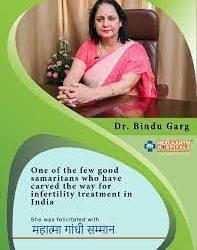
She was given the "Mahatma Gandhi Samman" to honor of her services in the treatment of infertility in India in a ceremony held at the House of Lords in London. She is passionate towards fulfilling the dream of parenthood in couples. She helps her patients in understanding their options and ability to take wise decisions regarding their reproductive health.
All her patients love her as they receive kind, individualized treatment from Dr. Bindu Garg, who is also the executive director of Neelkanth Hospitals in Patna and Gurgaon. She is better lknow as one of the top gynaecologists and IVF experts in Gurgaon and is passionate about assisting couples in realizing their aspirations of having a family.
#ivf specialist#infertility specialist#infertilitydoctor#gynecology clinic#gynecology hospital#gynecologist#best in gurgaon#ivfcentre in gurgaon#bestivfcentreingurgaon#bestivfhospital
2 notes
·
View notes
Text
Getting Pregnant With IVF: A Guide For All Mommy to be

Overview
In today’s society, in-vitro fertilization is a well-known term. Previously, this was referred to as a “test-tube baby.” In vitro fertilization (IVF) is a time-consuming, expensive, and sophisticated procedure that permits infertile couples to become parents.
IVF (in-vitro fertilization) is a blessing in disguise for people who have tried and failed to conceive. If you are planning to go for such a procedure, you are on the right page. In this blog, we have discussed a few facts you need to know before getting pregnant with IVF treatment. Our panel of IVF specialists in India has mentioned the same. So that we can help you out during your IVF pregnancy. Keep reading to know more.
How can you prepare your body for IVF pregnancy?
According to an experienced IVF doctor in India, you should follow a few rules when comes to getting pregnant with ART( Assisted Reproductive Techniques) way. These include the following-
Avoid smoking and alcohol as well.
Watch your diet. Have a healthy balanced meal enriched with necessary vitamins and minerals.
Start taking prenatal vitamins that include folic acid, vitamin C, vitamin A, vitamin E, B vitamins, zinc, and iodine are all nutrients that help prevent birth abnormalities and support brain and bone development in children.
Unless you have a food allergy, include eggs, milk, fish, nuts, seeds, and oats in your diet.
Reduce tension and get a better night’s sleep. Stress can be harmful to a pregnant woman, but breathing exercises and getting enough sleep can assist to a large extent.
Limit caffeine intake and drink plenty of water or fresh fruit juice. Drinking plain water aids in the removal of pollutants, but be careful not to overdo it.
It is preferable to begin this routine 3 to 6 months before the implantation.
Conclusion-By simply packing their medical journey to India, infertility treatment can substantially benefit the patient. We also offer a comprehensive range of counseling for coping with emotional changes to our international patients.How can we help in the treatment?If you are in search of a male infertility treatment in India, we will serve as your guide throughout your treatment and will be physically present with you even before your treatment begins. The following will be provided to you:Opinions of expert physicians and surgeonsTransparent communicationCoordinated carePrior appointment with specialistsAssistance in hospital formalities24*7 availabilityArrangement for travelAssistance for accommodation and healthy recoveryAssistance in emergenciesWe are dedicated to offering the highest quality health care to our patients. We have a team of highly qualified and devoted health professionals that will be by your side from the beginning of your journey.-with-ivf-a-guide-for-all-mommy-to-be
HealthTrip — #1 Health Travel & Tour Advisors | Medical Tourism in India
Experience the best health trip with a top medical travel company in India. Find the best hospitals, and doctors for medical treatment in India. Best Medical Tourism in India.
https://healthtrip.com/
#Overview#In today’s society#in-vitro fertilization is a well-known term. Previously#this was referred to as a “test-tube baby.” In vitro fertilization (IVF) is a time-consuming#expensive#and sophisticated procedure that permits infertile couples to become parents.#IVF (in-vitro fertilization) is a blessing in disguise for people who have tried and failed to conceive. If you are planning to go for such#you are on the right page. In this blog#we have discussed a few facts you need to know before getting pregnant with IVF treatment. Our panel of IVF specialists in India has mentio#How can you prepare your body for IVF pregnancy?#According to an experienced IVF doctor in India#you should follow a few rules when comes to getting pregnant with ART( Assisted Reproductive Techniques) way. These include the following-#Avoid smoking and alcohol as well.#Watch your diet. Have a healthy balanced meal enriched with necessary vitamins and minerals.#Start taking prenatal vitamins that include folic acid#vitamin C#vitamin A#vitamin E#B vitamins#zinc#and iodine are all nutrients that help prevent birth abnormalities and support brain and bone development in children.#Unless you have a food allergy#include eggs#milk#fish#nuts#seeds#and oats in your diet.#Reduce tension and get a better night’s sleep. Stress can be harmful to a pregnant woman#but breathing exercises and getting enough sleep can assist to a large extent.
3 notes
·
View notes
Text
Breastfeeding Myths and Facts: Separating Fiction from Reality

A wonderful and natural method to nourish your baby is breastfeeding. It gives your baby all the nutrients they need for healthy growth and development. Breastfeeding not only delivers the best nutrition for the infant, but it also has many other advantages for the mother.
Breastfeeding for the baby can help strengthen their immune system, lower their risk of illnesses, and minimise their risk of SIDS (sudden infant death syndrome). Additionally, breastfeeding fosters a close link between mother and child by providing safety and comfort to your infant.
Breastfeeding can help moms lose weight, cut their risk of postpartum depression, and lower their risk of developing certain cancers. Additionally, nursing generates hormones that facilitate bonding and relaxation, making it a wonderful method to establish a connection with your child.

Along with the beautiful journey of breastfeeding, it comes along with lots of myths and misconceptions. Many mothers are not even aware of the reality of these myths.
Breastfeeding is easy: It’s not easy to breastfeed a baby because a mother needs practical support with positioning the baby so that the baby can latch. Breastfeeding takes time and practice for both mothers and babies and is also time intensive, so mothers need space and support at home and work.
Mothers should only eat plain food while breastfeeding: breastfeeding mothers should need to eat a balanced diet. There is no need to change food habits unless the doctor suggests it.
You should separate the newborn baby and mother so that she can take rest: Doctors, nurses, and midwives encourage the practice of skin-to-skin contact immediately after the birth. Bringing the baby to direct contact with the mother helps to establish breastfeeding.
Mothers shouldn’t breastfeed if sick: Mothers can typically continue nursing when unwell, depending on the disease. You must ensure that you receive the proper care and enough rest, good nutrition, and hydration. Often, the antibodies your body produces to combat your sickness or illness will be passed on to your baby, helping him or her to develop their defences.
It’s hard to wean the baby if mothers breastfeed for more than a year: There is evidence that nursing for up to two years is advantageous for both women and children, but there is no proof that stopping breastfeeding beyond one year is more complicated. Since every mother and baby are unique, they must decide jointly how long to nurse.
Breastfeeding is a journey for mothers and babies that is both challenging and rewarding. In today’s generation, too many households believe in such myths and probably there is no one to debunk them. Filaantro along with Child Help Foundation has helped breastfeeding mothers understand the benefits of breastfeeding, the myths, and the facts. The organization has also established 18 Baby Feeding Centres in Pan India at hospitals, temples, and railway stations. Through this initiative, 56,615 beneficiaries have benefitted. Thus, helping mothers with a safe and secure haven to comfortably breastfeed their babies.
#filaantro#crowdfunding#fundraising#charity#education#donations#nonprofits#raise funds#donate#volunteering#world breastfeeding week#breastfeeding#breastfeeding tips#breastfeeding moms
1 note
·
View note
Text
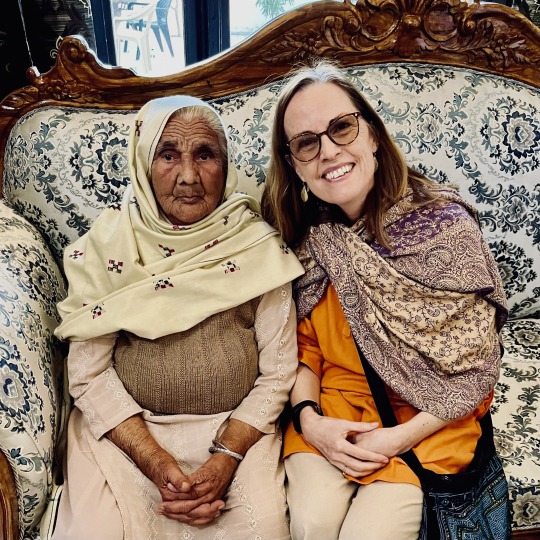
The Good...
January 26, 2023 (Thank you, Kathy Sabino! I was stuck in 2022!)
Yesterday was Republic Day in India. The day in 1950 when the constitution of a new, independent India came into effect. Interesting that I find two different meanings of the holiday on Google. The other: that it is the day in 1930 that the Indian National Conference committed to independence.
We learned, the hard way, that it is not an ideal day to travel! With no explanation offered (and combined with my ignorance about the holiday), our original two flights to Varanasi were cancelled last week- then one of the replacement flights (from Delhi to Varanasi) was changed to 30 minutes earlier departure. We thought we’d make it—but we didn’t understand the madness of Delhi airport. We had to shift terminals (two different airlines)—and that is like shifting to a completely different airport. 30 minutes to travel from one to another—as we watched the window for our connection whither away. Finally, it was explained that airspace was being cleared from 10-12 for an airshow celebrating the holiday. Ah. Welcome to India. This must have been decided last week: thus, the cancellations and changes.
It all worked out fine. We checked into a nice Radisson near the airport (a little pricey for us- but we were exhausted and stressed.) We ordered in pizza, drank beer from the minibar (Republic Day a “dry day” for the city)- and best of all, I took advantage of the hot shower and STEAM ROOM in the spa. After a month of dicey hot water and bucket baths—it was glorious.
Now on to Varanasi, which promises to be an adventure, so I wanted to get caught up.
The last week has been one of big highs and big lows. I think I’ll focus on the highs, for now.
Last Saturday, we traveled with three students to border villages to interview Partition survivors and others with family stories from relatives who have passed. At every stop we were welcomed with incredible warmth and hospitality. We met one Partition survivor—the great grandfather of our travel companion Hardeep. This gentleman was twenty at the time, (making him now 95/96). His wife and infant daughter traveled by train across the border (a risky journey—many trains arrived at their destination full of slaughtered men, women, and children). He traveled on foot with a kafila. Of course, the wife and daughter would arrive long before he did—and the husband and wife made a plan to meet at a certain bridge near their destination. Days later, they were reunited—all safe. He told us he left many Muslim friends back in Pakistan—and he pulled out a well-worn diary to show us their phone numbers. They remain in touch to this day.


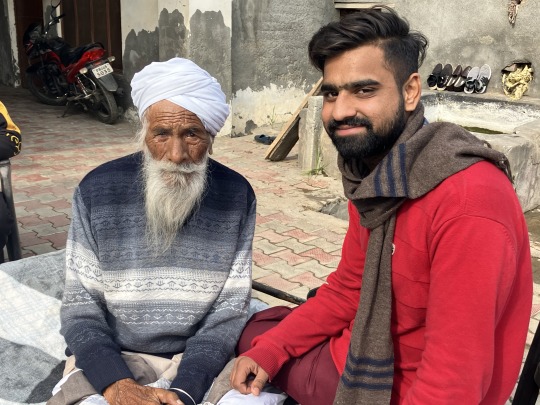
After that interview, we visited various homes of our student hosts. One village we visited was Batala. By a rather incredible coincidence, I had received a message that morning from a friend, Umar, who Sarah and I met in Islamabad back in 2015. He had arranged for us to interview his grandfather, a Partition survivor. Due to tight security in Pakistan, it was the one interview I was able to attend for our 2015 project, and I fell immediately in love with the grandfather. I remember his story of traveling on a train to Pakistan with his uncle. The train was attacked, and they were separated. For days, they did not know if the other had survived. Finally, they made it to a refugee camp, where they waited for the women and children of their family to join them. It took several weeks, in which time they had no information about the welfare of those family members.
Umar messaged me that morning to tell me that it was the one-year anniversary of his grandfather’s death. He wondered if we had a copy of the interview and expressed his regret that he didn’t ask for it at the time. I promised to look into it and asked him what village his grandfather had emigrated from. Batala. I couldn’t believe it. We were going there that day! He did not know the specific address. But I promised to send a picture and to say a prayer for his grandfather. I sent these pictures of the green fields around Batali, and he wrote back that his grandfather shared how he used to sneak into those fields to get fruit as a boy. Umar said, “ This is so calming for me to see—in a strange way I feel connected to this place.”


In addition to the family visits on that day, we visited a special border corridor open to Indian nationals wishing to visit one of the Sikh sacred sites now in Pakistan. This was one of the tragedies of Partition. The Punjab is the home of the Sikhs and the origin of their religion. When Radcliffe drew his line, many of the most sacred sites (including the birthplace of the first guru) were in Pakistan. We were not allowed to cross over (only Indian citizens.) But we could see, up close, that harsh metal fence cutting through the fields.



Our last stop was at the shores of the Ravi River. One lonely soldier seemed to be in charge of that outpost—and the poor guy was in a shower stall bathing at the time of our stop. We tried to steer clear and give him some privacy! The spot was breathtaking—and we looked across to Pakistan on the opposite shore. I imagined the refugees from both sides stealing across –most likely at night—praying that they and their families would cross safely.
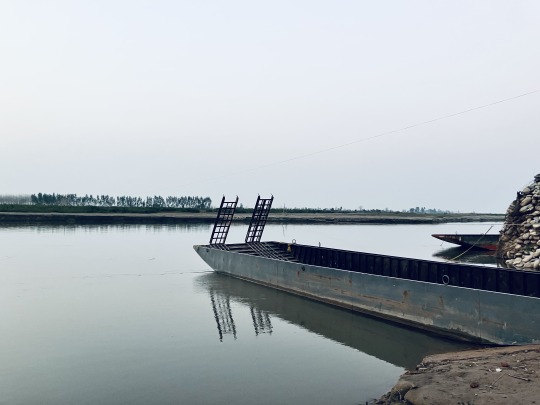
The next day we were off to the border villages again, this time with director Emanuel and student Priya, who has been serving as one of our translators. Again, we were welcomed with unparalleled hospitality. The interviews with Partition survivors were gatherings for the whole family. One of my goals for this project is to connect young people with the stories of those who came before them—and I was happy to see family members young and old sitting and listening as their elders talked.

And wow, do they talk! It is as if these stories have been waiting to burst forth for decades. Once each got started, the stories poured out. We only got occasional translations, and that was fine. The stories were recorded and collected—that was the objective.
I have nicknamed the first woman we interviewed the Apple Dumpling Lady. I remember seeing those folk dolls from New England with faces created out of dried apples. Her face reminded me of one. What an incredible face! She was, as far as we could calculate, 88--and sharp as a tack (as have been all of the survivors so far.) At the end of the interview, I went to thank her and she blessed me. I loved her.


Later that day, we arrived at the house of a friend of Emanuel’s. After a warm welcome from the family, a son visiting from Canada told us that they had arranged for us to interview the couple next door: both Partition survivors and both in their 90’s. “Would you like to go to them, or would you like them to come to us?” I said that considering they were in their 90’s, wouldn’t it be best if we went to them?!
We walked across the road and entered the traditional courtyard (complete with cows.) We were welcomed by generations of the family, and then ushered into a small room in which a man and a woman wrapped in layers of blankets and shawls (it was very cold!) sat on charpoys. They had both emigrated in 1947- both at 13 years old. They married two years later and have been married for 73 years. He told us that she traveled by foot and had more stories—so he let her do most of the talking. While I didn’t understand much, I did learn that she was one of three daughters in the family. She traveled on foot with her sisters and her parents. They left most of their valuable possessions in Pakistan (like so many, they assumed they would return after things cooled down.) Her father said, “If I reach India and my wife and daughters are safe, everything I value will be with me.” At night, she said, the women in the kafila slept in the middle, encircled by the men, who took turns keeping watch. They all made it safely across the border after 22 days. “Your father did what he said he’d do”, I said. She nodded—her eyes filling with tears.



Every visit includes the essential group photo. And then, often, individual photos with various family members or groups.
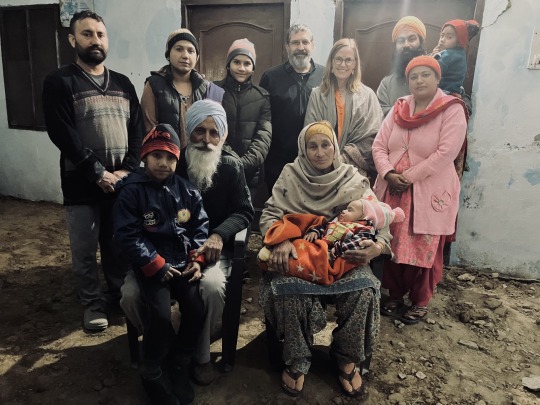

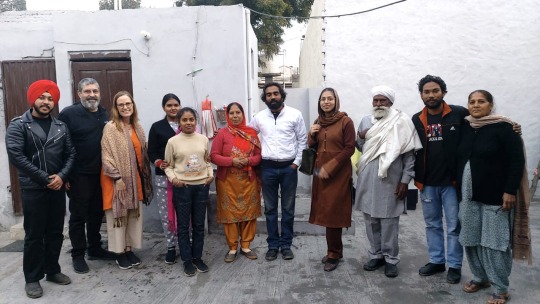
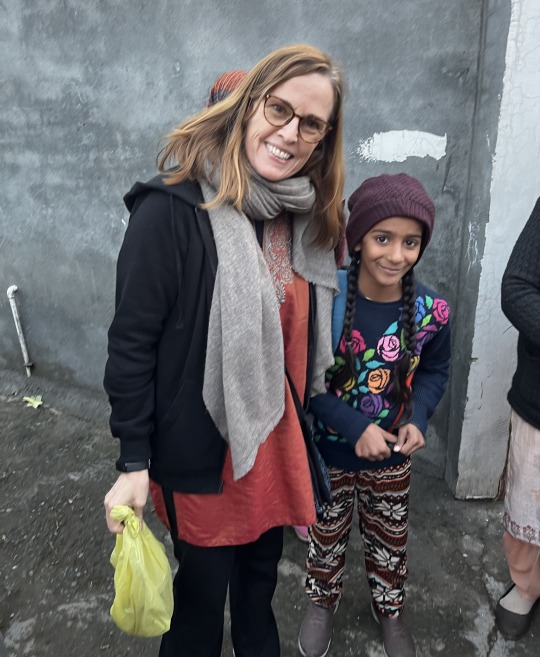

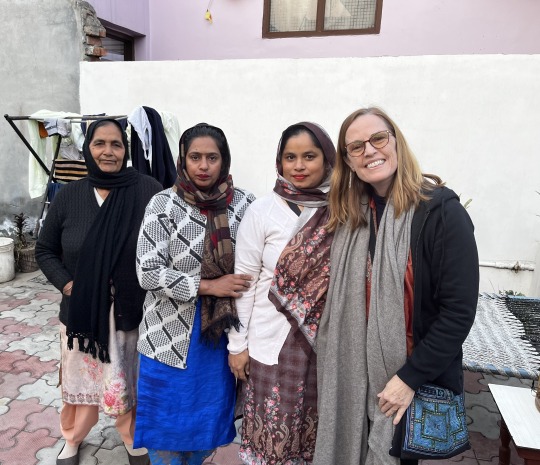
Also- the random people we pass by who want a photo with us, or one with us and their children. I should have quite a collection by the end of this journey.

4 notes
·
View notes